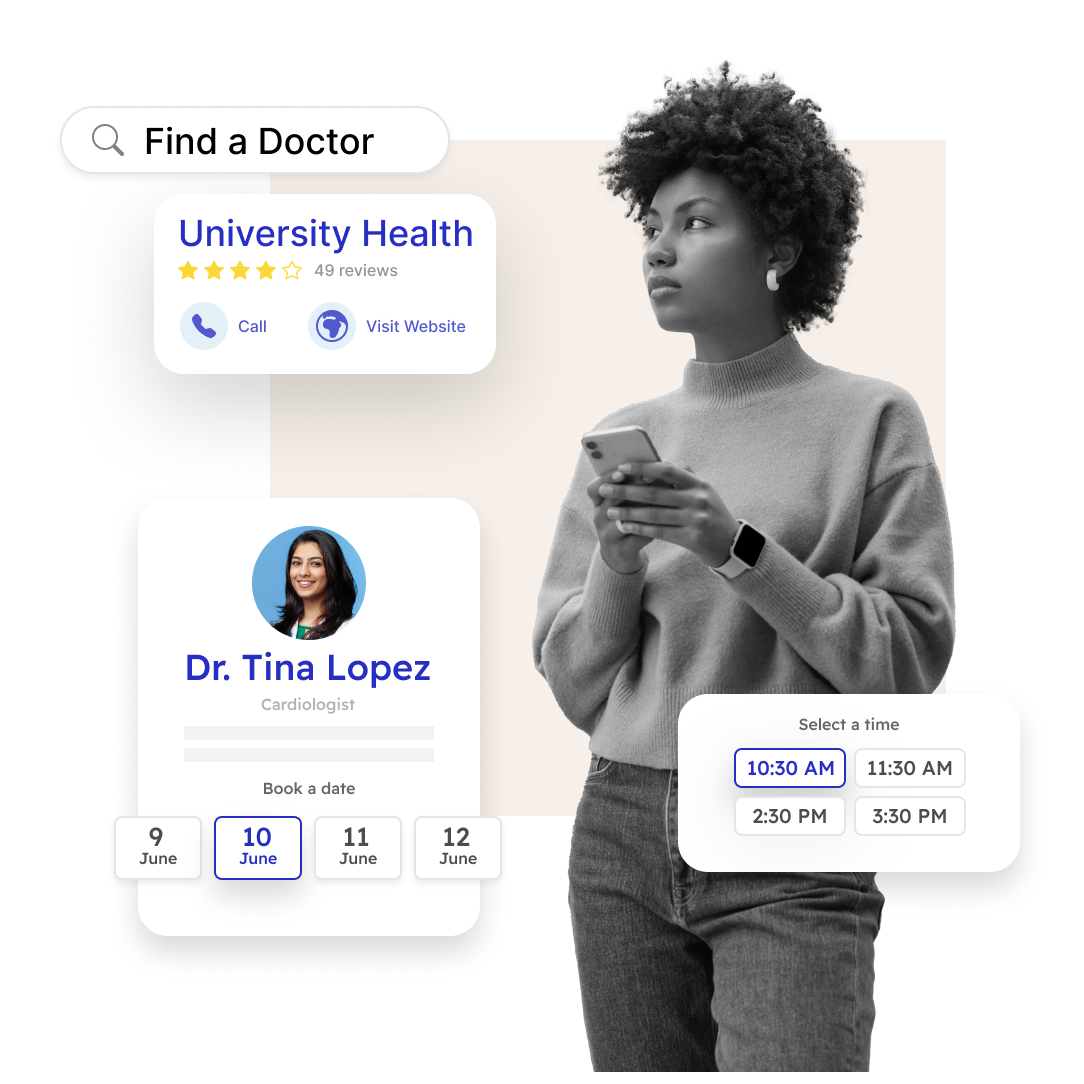Balance Peaks In Demand With Telehealth Software

The Benefits of a Telemedicine Platform
Virtual care has positive reviews by patients and healthcare professionals but is still underutilized in the United States despite its potential to address a range of healthcare challenges. While the use of virtual care is 38 times higher than before the COVID-19 pandemic, telehealth visits are estimated to represent just 5.8% of total healthcare visits.
Embracing virtual on-demand and integrating it as part of a provider’s care delivery model can have significant cost benefits and patient experience impact. Fully leveraging telemedicine services can help address the shortage of clinicians, health system capacity issues, and long delays for patients, particularly those in rural areas.
Hoy Garvin, the executive director of on-demand care at Community Health Network, an Indianapolis-based organization of more than 200 sites of care, shared how virtual on-demand has evolved into a strategic healthcare delivery channel in a recent webinar. He also outlined how it has improved patient access and helped balance capacity across care options.
Webinar Featuring Community Health Network: How to Tackle Capacity Issues and Treat More Patients
On-demand services are defined as same-day care options – brick-and-mortar urgent care centers, retail clinics, and virtual urgent care. Hoy indicated that the mission of these on-demand services is to be the front door to the organization to attract patients, connect them to medical care, and drive brand loyalty and retention. It has also been essential in balancing capacity during peak times such as cold and flu season.
Like many health systems, Community Health Network (CHNw) is in a competitive market and is exploring how to build, buy, and partner to ensure service line growth. The DexCare partnership began in 2021 to attract new patients and provide a seamless, easy-to-use experience for them. Hours of operation are 7am-11pm seven days a week and patients can elect to pay a flat fee or use their insurance. Being able to use commercial insurance for new patients has been a differentiator in the market for CHNw.
Telehealth is Your Digital Front Door
The Virtual on-demand experience at CHNw has been very positive. They currently have twenty different use cases for virtual on-demand. Two-thirds of virtual care visits have been highly satisfied returning patients. The average NPS (Net Promoter Score) for this group is 90+, well above the industry average of 38. For about a third of patients, it’s their first virtual visit. Of those first-time virtual care patients, 12% are completely new to the CHNw health system.
Hoy shared an example of a recent patient with abdominal pain. While the provider was unable to examine the abdomen during the virtual visit, it was a suspected case of appendicitis. The provider referred the patient to the emergency department who was fast-tracked to care. The ED was alerted to the patient coming in for treatment via patient records. The patient received timely care and stayed within the CHNw health system.
Last year, CHNw had over $12 million in network service utilization tied to telehealth platform visits. That is $12 million in net revenue from patients whose first experience was with the virtual care department. Then they went on to use other services at the health system.
A Virtual First Approach Expands Your Footprint and Reach
With the expansion of virtual on-demand, Community Health Network can treat patients across the state and beyond. Virtual care and video communications with providers has led to easy access for patients in the surrounding communities who may not have a local care option. Virtual visits have increased by 6X over time. What’s more, patients treated in rural areas have doubled since launch.

Creating a Best-in-Class Virtual Care Team
CHNw takes a unique approach to staffing its virtual care program. It is led by a dedicated Advanced Practice Provider (APP) virtual team under the clinical leadership of the medical director. The team was selected due to their high affinity to remote virtual care work – they have a combination of high NPS scores and high productivity. This approach has led to increased APP utilization and satisfaction, as well as expanded scope of practice.
Hoy states that having a nimble, dedicated team that enjoys virtual care work has proven to be more efficient than having a clinician switch gears back and forth between in-person visits and virtual visits. In addition, with the DexCare platform, a member of the care team can chat with patients waiting in the queue to ensure everything is prepped for the online visit. This approach further contributes to the care team being able to see more patients with the same number of resources.
Using Data to Make Decisions
Understanding when historical peaks and valleys in demand volume occur daily, weekly, monthly, or by season informs staffing and shift decisions. This helps control healthcare costs and balance workloads. Leveraging insights such as NPS scores for providers, visit wait and duration times surface best practices that can be shared across the virtual care team.
In addition, mining the aggregate patient data across all visits enables health systems to better understand the consumer segments who are using virtual care and their reasons for visit (conditions). These insights inform how to better serve the patient population and can spawn new ideas for patient services.
Ramping Up Efficiently During Peaks in Demand
Having a satisfied pool of virtual clinicians has led to a better patient experience and improved attraction and retention. During the busy cold and flu season, if there is a surge in demand, CHNw can send out same-day communications to the virtual care team to inquire if anyone is willing to log in for a few hours to help address the inflow of patients looking for care.
Getting clinicians to jump on their computers for a few hours from their home office is much easier than asking them to get in their car and drive in to work in the urgent care for just a couple of hours.
Numbers that Make Your CFO Happy
Mr. Garvin shared that last January, a typical cold and flu season month, CHNw saw an increase in their visit volume of 26% over their typical volume at their traditional urgent care clinics. The labor cost correlated with that with a jump of 27%. That is a significant increase for healthcare organizations with tight margins. The labor cost was higher than budgeted at traditional urgent care.

But for virtual care, despite the 52% increase in volume, labor cost only increased by 10%. The highly efficient virtual care providers could see a lot of patients at a much lower cost. While in a busy urgent care, there are additional factors that can impact the number of patients seen per day – the number of exam rooms, how quickly they are turned over, locating supplies, and other factors.
CHNw is also encouraging urgent care clinic patients to try virtual on-demand on their phones. It provides those new to virtual on-demand the opportunity to try a visit. Their spot in the urgent care line is saved for them. Hoy draws a comparison to the Disney fast pass for patients in healthcare. “When you don’t feel well, you just want to get in, get care, get your prescription, and get on with your day.” Patients have a shorter wait time and this reduces congestion at traditional urgent care clinics.
What’s Next: Innovating Virtual Care
Community Health Network is continuing to innovate and look for opportunities to take a digital approach. For example, CHNw is evaluating how to reduce the burden on physicians by shifting some of the after-hours primary care that occurs in patient MyChart messages to an eVisit – such as a medication adjustment. Other areas being explored for virtual care are annual wellness visits, behavioral health, and primary care. A number of behavioral health providers and organization have launched mental health services via telehealth – a trend born out of the pandemic. The best telemedicine software will help your health system innovate for the future, building out new service lines for virtual care with care orchestration and capacity mapping to support this endeavor.
Key takeaways: telemedicine software features and benefits
- Capacity Management: virtual on-demand urgent care can be leveraged to efficiently manage spikes in demand, especially during cold and flu season or COVID outbreaks. The model can more easily scale up as needed and is more efficient.
- Expansion to new markets: a virtual on-demand option enables you to go beyond your physical footprint and serve new consumers looking for medical services, such as treating patients in rural areas. The expanded hours also provide additional options for busy parents and professionals to care outside of typical 9-5.
- Data-Driven Decision Making: Operational data can be used to understand provider best practices, peaks and valleys in demand, patient preferences and needs, and opportunities for optimization.
- Patient Access: Virtual on-demand care offers patients a convenient, easy-to-use healthcare experience. Patients can get care from home or wherever they are, reducing wait times and improving access. They can even get into a virtual queue on their phone if the urgent care clinic they are visiting has a long wait time.
- Provider Satisfaction: CHN uses a pool of dedicated medical professionals who enjoy and excel at virtual visits. This approach ensures APPs are working at top of license which drives high provider satisfaction and utilization, as well as high patient satisfaction.
DexCare is focused on helping healthcare systems optimize capacity, connect patients with the right care venues, and enhance patient access. Our team is continuously innovating and developing key features like multi-credential flexibility and overflow provider capabilities to meet increasing demand.
Telemedicine software allows medical professionals to communicate with patients and offer healthcare services remotely, typically via hipaa compliant video conferencing.
Telemedicine software is a digital platform that enables healthcare providers to deliver medical services remotely through video conferencing, phone calls, and messaging apps. The primary purpose of telemedicine software is to provide patients with convenient and accessible healthcare services, regardless of their geographical location. This technology has revolutionized the way healthcare is delivered, making it possible for patients to receive medical care from the comfort of their own homes. By bridging the gap between patients and healthcare providers, telemedicine software ensures that quality medical services are just a click away, enhancing patient satisfaction and improving health outcomes.
Protecting patient data is a top priority for telemedicine software providers. To ensure the security and confidentiality of patient data, telemedicine software providers should implement the following measures:
- Encryption: Patient data should be encrypted to prevent unauthorized access, ensuring that sensitive information remains confidential.
- Secure Servers: Patient data should be stored on secure servers that are protected by firewalls and intrusion detection systems, safeguarding against cyber threats.
- Access Controls: Access to patient data should be restricted to authorized personnel only, ensuring that only those with a legitimate need can view or modify patient information.
- Audit Trails: Telemedicine software providers should maintain audit trails to track all access to patient data, providing a record of who accessed what information and when.
- Training: Telemedicine software providers should provide training to healthcare providers on the secure use of the platform, ensuring that all users understand best practices for data protection.
By implementing these measures, telemedicine software providers can ensure the security and confidentiality of patient data, maintaining the trust of patients and healthcare providers.

